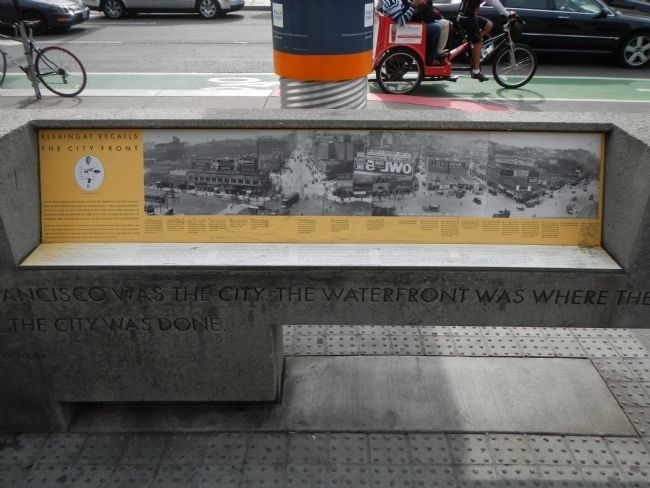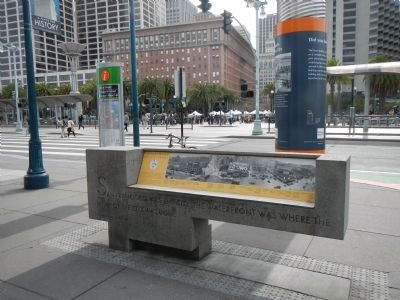Embarcadero in San Francisco City and County, California — The American West (Pacific Coastal)
Klebingat Recalls The City Front
Captain Fred Klebingat was 24 years old when the panorama at the right was made from the Ferry Tower. He had sailed into San Francisco in 1908, as a seaman-donkeyman on the S.N. Castle. In 1979, at the age of 90, he walked the city front recalling life through the years on what was East Street in his youth. He studied the four-part 1913 panorama: "Well, it was like this, you see." and the Captain was off on a fresh memory.
Over the years, starting in 1953, Karl Kortum, Director of the San Francisco Maritime Museum, listened intently to Captain Klebingat, setting down the captain’s detailed recollections of 57 years at sea – mostly in the Pacific, "My home from home." From seaman to captain of square-rigged vessels in the South Seas; he mastered a range of vessels, from Hollywood yachts to Liberty ships. Captain Klebingat died in Coos Bay, Oregon, aged 95 – his words set here in italics are the real thing - "Well, maybe I was wrong 2% of the time."
View from the Ferry Tower, June 3, 1913
Around noon, on that Tuesday, a photographer climbed the tower steps up the 220 feet, set up his camera and loaded it with a seven-inch glass plate – not once but four times. Each time he shifted his camera’s tripod carefully to make an overlap for a panoramic view of the waterfront. What he captured was an ad man’s dream, the prime place to push your product. Where else could you be sure of reaching 60,000 people – not once a day, but twice. Twenty-three ferry boats made 180 trips a day, carrying a total of 12,000 fares every working day. Weekends carried half as many, but locals and tourists had a little money in their pockets. Such were the times, that it didn’t take much. At 16 Embarcadero (directly above) Yosemite beer, at 5 cents a glass is advertised in stained art glass. In 1913 prices stay in place long enough to only post
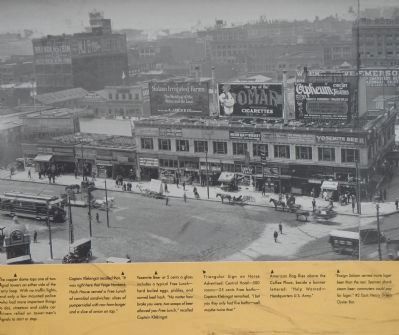
Photographed By Barry Swackhamer, March 20, 2014
2. Ferry Tower Panorama, part 1
Panorama captions, presented left to right:
The copper dome tops one of two signal towers on either side of the Ferry loop. With no traffic lights, and only a few mounted police (who had more important things to do), streetcar and cable car drivers relied on tower-men’s signals to start and stop.
Captain Klebingat recalled that, ”It was right here that Feige Hanson’s Hash House served a Free Lunch of cannibal sandwiches: slices of pumpernickel with raw ham-burger and a slice of onion on top.”
Yosemite Beer at 5 cents a glass includes a typical Free Lunch – hard boiled eggs, pickles, and corned beef hash. ”No matter how broke you were, two scoops of beer allowed you Free Lunch,” recalled Captain Klebingat.
Triangular Sign on Horse Advertised Central Hotel – 500 rooms – 25 cents Free baths – Captain Klebingat remarked, ”I bet you they only had five baths-well, maybe twice that.”
American flag flies above the Coffee Palace, beside a banner lettered: “Help Wanted – Headquarters U.S. Army.”
”Ensign Saloon served more lager beer than the rest. Seamen drank steam beer; commuters could pay for lager.” #2 East; Henry Dree’s Oyster Bar
The copper dome tops one of two signal towers on either side of the Ferry loop. With no traffic lights, and only a few mounted police (who had more important things to do), streetcar and cable car drivers relied on tower-men’s signals to start and stop.
Captain Klebingat recalled that, ”It was right here that Feige Hanson’s Hash House served a Free Lunch of cannibal sandwiches: slices of pumpernickel with raw ham-burger and a slice of onion on top.”
Yosemite Beer at 5 cents a glass includes a typical Free Lunch – hard boiled eggs, pickles, and corned beef hash. ”No matter how broke you were, two scoops of beer allowed you Free Lunch,” recalled Captain Klebingat.
Triangular Sign on Horse Advertised Central Hotel – 500 rooms – 25 cents Free baths – Captain Klebingat remarked, ”I bet you they only had five baths-well, maybe twice that.”
American flag flies above the Coffee Palace, beside a banner lettered: “Help Wanted – Headquarters U.S. Army.”
”Ensign Saloon served more lager beer than the rest. Seamen drank steam beer; commuters could pay for lager.” #2 East; Henry Dree’s Oyster Bar
Steam Beer – 5 cents a scoop – so was a good cigar
Captain Fred Klebingat recalled, ”San Francisco in those days was known all up and down the Pacific Coast as ‘The City’; the Embarcadero was known as East Street; and all this part of town was known as ‘The City Front’. It was here that the work of the city was done. If you walked in the Ensign Saloon and called “Captain” – half the men in the place would look up. If I was in the money, I’d get oysters at Herman Dree’s, washed down with lager, and have a steam-towel shave and shine on my boots. You’d know it was summer in this picture – June 1st was Straw Hat Day – but I never wore such a thing. It was like this – the big talk around 1913 was the Panama Canal – due to open in 1914. Think what it meant for San Francisco shipping, if you didn’t have to fight your way around Cape Horn with freezing seas over the deck.”
You could buy a house cheaper than a car
“Horses still did most of the heavy pulling on the waterfront,” Klebingat recalled. ”Big iron wheels made a terrible racket on the paving.” At Market Street, two buggies tear around the corner, as the sidewalk group admires the smart open roadster parked by the curb. The June 3rd Morning Call

Photographed By Barry Swackhamer, March 20, 2014
3. Ferry Tower Panorama, part 2
Panorama captions, presented left to right:
”Ensign Saloon served more lager beer than the rest. Seamen drank steam beer; commuters could pay for lager.” #2 East; Henry Dree’s Oyster Bar.
Market Street (120 feet wide) with four street car tracks, joined by a cable car slot coming off Sacramento Street on the right. On the left, Steuart Street comes into Market, followed by Spear and Main streets, father west.
Advertised Hotel Rates: Terminal Hotel on Market, rooms started at $1.00 or $1.500 with bath. Bay Hotel: 50 cents & up; Other hotels: 30 cents & up; Cosmopolitan – 20 cents per cubicle.
OWL has been spelled backwards so that you would ask about this monumental error with the hoped-for result: remember OWL when you bought your next cigar.
”Ensign Saloon served more lager beer than the rest. Seamen drank steam beer; commuters could pay for lager.” #2 East; Henry Dree’s Oyster Bar.
Market Street (120 feet wide) with four street car tracks, joined by a cable car slot coming off Sacramento Street on the right. On the left, Steuart Street comes into Market, followed by Spear and Main streets, father west.
Advertised Hotel Rates: Terminal Hotel on Market, rooms started at $1.00 or $1.500 with bath. Bay Hotel: 50 cents & up; Other hotels: 30 cents & up; Cosmopolitan – 20 cents per cubicle.
OWL has been spelled backwards so that you would ask about this monumental error with the hoped-for result: remember OWL when you bought your next cigar.
“Boss of the Road” – City Front – A Man’s World
“No women on the Front,” Captain Kibbling recalled: “Women you saw in a stream morning and night, crossing from the Ferry Building to Market Street, and back again. But not many others around. A few Salvation Army lasses, beating the drum on the street corner at night, part of the band. Maybe a whore or two in the waterfront hotels, but mostly that class of women congregated on the Barbary Coast – some distance away. You were safe on East Street at any time. The San Francisco waterfront was not a riotous scene filled with drunken sailors, as some romantic writers would have it. San Francisco cops kept things in hand: they might
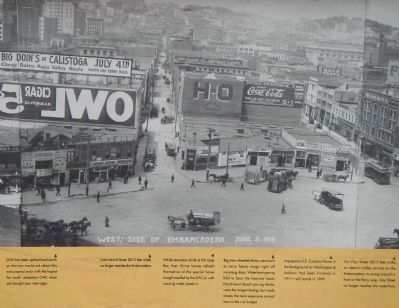
Photographed By Barry Swackhamer, March 20, 2014
4. Ferry Tower Panorama, part 3
Panorama captions, presented left to right:
OWL has been spelled backwards so that you would ask about this monumental error with the hoped-for result: remember OWL when you bought your next cigar.
Commercial Street (82.5 feet wide) no longer reaches the Embarcadero.
While teamsters drink at the Loop Bar, their thirsty horses refresh themselves at the special horse trough installed by the S.P.C.A. with running water piped in.
Big iron-wheel drays were built to carry heavy cargo right off incoming ships. Waterfront paving has to bear the heaviest loads. Hand-hewn basalt paving blocks were the longest lasting, but made streets the most expensive annual item in the city budget.
Impressive U.S. Customs House in the background on Washington & Jackson had been finished in 1911 – still stands in 1999.
On Clay Street (82.5 feet wide) an electric trolley arrives on the Embarcadero, to swing around in front of the Ferry Loop. Clay Street no longer reaches the waterfront.
OWL has been spelled backwards so that you would ask about this monumental error with the hoped-for result: remember OWL when you bought your next cigar.
Commercial Street (82.5 feet wide) no longer reaches the Embarcadero.
While teamsters drink at the Loop Bar, their thirsty horses refresh themselves at the special horse trough installed by the S.P.C.A. with running water piped in.
Big iron-wheel drays were built to carry heavy cargo right off incoming ships. Waterfront paving has to bear the heaviest loads. Hand-hewn basalt paving blocks were the longest lasting, but made streets the most expensive annual item in the city budget.
Impressive U.S. Customs House in the background on Washington & Jackson had been finished in 1911 – still stands in 1999.
On Clay Street (82.5 feet wide) an electric trolley arrives on the Embarcadero, to swing around in front of the Ferry Loop. Clay Street no longer reaches the waterfront.
The Cosmopolitan Hotel: 20 cents a night
”I climbed the stairs with my shipmate Jack Van Barm;” Klebingat recollected, ”Into a big hall divided with a running partition about six feet high. This hall was a maze of alleyways, with a door leading to each cubicle; the strong stench of crowded humanity prevailed. Jack’s enclosure had a cot and a pillow and some blankets. ‘This is all I can afford,” Jack said, ‘Just this morning a head stuck up over this low wall and says to me, “What time is it?” All at once, I knew that it was a damn easy way to rob a guy.’ ‘Yes,’ said I, ‘And you wearing that gold chain. Why not raise some money on it? I don’t have much, but I can lend you a few bucks. And you can raise money on that gold watch chain.’ Jack grabbed his bag, and we left. Later, I was told that they nailed chicken wire up, to stop the guests from climbing from one cell to another.”
”Even In My Time The City Front Was Changing”
“Some seafaring men moved further up town, looking for a furnished room with a family. People liked this kind of lodger; he was
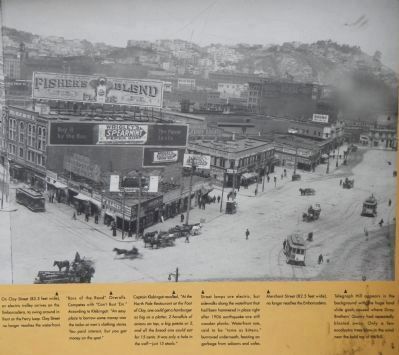
Photographed By Barry Swackhamer, March 20, 2014
5. Ferry Tower Panorama, part 4
Panorama captions, presented left to right:
On Clay Street (82.5 feet wide) an electric trolley arrives on the Embarcadero, to swing around in front of the Ferry Loop. Clay Street no longer reaches the waterfront.
“Boss of the Road” Overalls Competes with ”Can’t Bust ‘Em.” According to Klebingat: ”An easy place to borrow some money was the tailor at men’s clothing stores. You paid interest, but you got money on the spot.”
Captain Klebingat recalled, ” At the North Pole Restaurant at the Foot of Clay, one could get a hamburger as big as a platter, 2 handfuls of onions on top, a big potato or 2, and all the bread one could eat for 15 cents. It was only a hole in the wall – just 15 stools.”
Street lamps are electric, but sidewalks along the waterfront that had been hammered in place right after 1906 earthquake are still wooden planks. Waterfront rats, said to be “tame as kittens.” Burrowed underneath, feasting on garbage from saloons and cafes.
Merchant Street (82.5 feet wide), no longer reaches the Embarcadero.
Telegraph Hill appears in the background with the huge land slide gash caused where Gray Brothers’ Quarry had repeatedly blasted away. Only a few eucalyptus trees blow in the wind near the bald top of the hill.
On Clay Street (82.5 feet wide) an electric trolley arrives on the Embarcadero, to swing around in front of the Ferry Loop. Clay Street no longer reaches the waterfront.
“Boss of the Road” Overalls Competes with ”Can’t Bust ‘Em.” According to Klebingat: ”An easy place to borrow some money was the tailor at men’s clothing stores. You paid interest, but you got money on the spot.”
Captain Klebingat recalled, ” At the North Pole Restaurant at the Foot of Clay, one could get a hamburger as big as a platter, 2 handfuls of onions on top, a big potato or 2, and all the bread one could eat for 15 cents. It was only a hole in the wall – just 15 stools.”
Street lamps are electric, but sidewalks along the waterfront that had been hammered in place right after 1906 earthquake are still wooden planks. Waterfront rats, said to be “tame as kittens.” Burrowed underneath, feasting on garbage from saloons and cafes.
Merchant Street (82.5 feet wide), no longer reaches the Embarcadero.
Telegraph Hill appears in the background with the huge land slide gash caused where Gray Brothers’ Quarry had repeatedly blasted away. Only a few eucalyptus trees blow in the wind near the bald top of the hill.
On the front of the podia
San Francisco was the City, the Waterfront was where the work of the City was done – Captain Fred Klebingat
Erected by San Francisco Art Commission for the Waterfront Transportation Projects.
Topics. This historical marker is listed in these topic lists: Industry & Commerce • Waterways & Vessels. A significant historical date for this entry is June 3, 1937.
Location. 37° 47.724′ N, 122° 23.633′ W. Marker is in San Francisco, California, in San Francisco City and County. It is in Embarcadero. Marker is on The Embarcadero near Market Street. Touch for map. Marker is at or near this postal address: 1 The Embarcadero, San Francisco CA 94105, United States of America. Touch for directions.
Other nearby markers. At least 8 other markers are within walking distance of this marker. Ferry Building (a few steps from this marker); Fruit Seller (a few steps from this marker); Signs of History (within shouting distance of this marker); Port Time (within shouting distance of this marker); Freeway Supports (within shouting distance of this marker); San Francisco Vietnam Veterans Memorial (within shouting distance of this marker); The Abraham Lincoln Brigade (about 300 feet away, measured in a direct line); Stephan C. Leonoudakis (about 400 feet away). Touch for a list and map of all markers in San Francisco.
More about this marker. This marker is on a podia located in front of the Ferry Building.
Credits. This page was last revised on February 7, 2023. It was originally submitted on April 1, 2014, by Barry Swackhamer of Brentwood, California. This page has been viewed 790 times since then and 25 times this year. Photos: 1, 2, 3, 4, 5, 6. submitted on April 1, 2014, by Barry Swackhamer of Brentwood, California. 7. submitted on October 5, 2020. • Bill Pfingsten was the editor who published this page.
